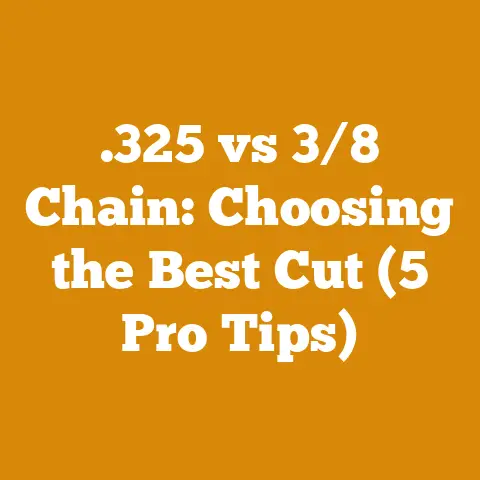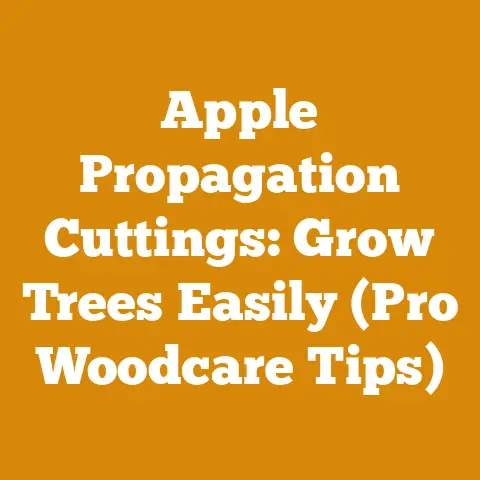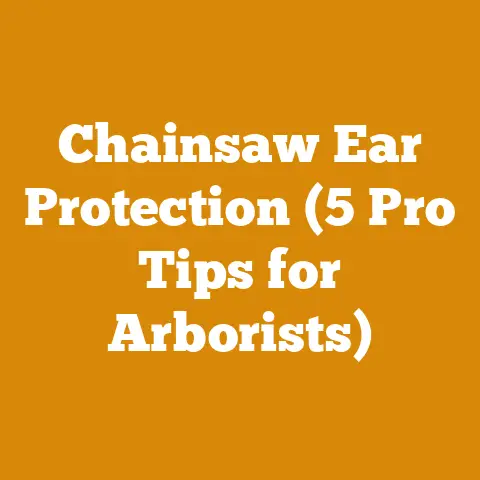Winch for Pulling Trees (5 Pro Tips for Wood Harvesting)
For years, I’ve found a deep satisfaction in the rhythm of splitting wood, the scent of freshly cut timber, and the warmth of a crackling fire on a cold winter’s night. It’s more than just a chore; it’s a connection to something primal, a way to provide for my family and heat our home. But as the years have passed, I’ve learned that the initial joy of felling trees can quickly turn into a back-breaking ordeal if you’re not equipped with the right tools and techniques. That’s where the trusty winch comes in. Specifically, a winch for pulling trees.
The reality is, many of us aren’t professional loggers with access to heavy machinery. We’re weekend warriors, hobbyists, or small-scale firewood producers trying to sustainably manage our land and efficiently harvest wood. And in that context, a winch is a game-changer. It allows you to safely and effectively move trees that are too large or awkwardly positioned to handle manually. But simply owning a winch isn’t enough. You need to know how to use it properly to maximize its potential and avoid dangerous situations. Through trial and error, countless hours in the field, and a healthy dose of research, I’ve developed a few “pro tips” that have significantly improved my wood harvesting process. These tips focus on using a winch safely and efficiently for pulling trees.
1. Anchoring Like a Pro: The Foundation of Safe Winching
The anchor point is the single most critical factor in safe and effective winching. If your anchor fails, the entire operation is compromised, and the potential for injury is significant. I once witnessed a near-miss when a novice used a small, decaying tree as an anchor point. The tree snapped under the strain, sending the winch cable whipping through the air. Thankfully, no one was hurt, but it served as a stark reminder of the importance of proper anchoring.
Understanding Anchor Point Strength:
- Minimum Requirement: Your anchor point must be able to withstand at least twice the pulling force of your winch. This is a safety factor built in to account for dynamic loads and unexpected stresses.
- Tree Diameter: As a general rule, use trees with a diameter of at least 12 inches at chest height (DBH) for anchoring a standard portable winch. For larger trees or heavier pulls, increase the diameter accordingly.
- Tree Species: Hardwoods like oak and maple are significantly stronger than softwoods like pine and spruce. When using a softwood tree as an anchor, choose one with a larger diameter and ensure it is healthy and free of rot.
Anchor Point Selection Criteria:
- Healthy and Stable: The tree must be alive, healthy, and firmly rooted in the ground. Avoid trees that are leaning, showing signs of decay, or have shallow root systems.
- Diameter and Species: As mentioned above, consider the tree’s diameter and species when assessing its strength.
- Angle of Pull: Ideally, the anchor point should be directly in line with the direction of pull. This minimizes stress on the tree and winch cable. If an angled pull is necessary, use a snatch block to redirect the cable and distribute the load more evenly.
- Environmental Factors: Be aware of soil conditions. Soft or saturated soil can reduce the stability of the anchor tree.
Anchor Techniques:
- Tree Straps: Use high-quality tree straps designed for winching. These straps are made from durable materials like nylon or polyester and have a wide surface area to distribute the load evenly around the tree trunk.
- Minimum Breaking Strength (MBS): Ensure the tree strap’s MBS is at least twice the pulling force of your winch.
- Width: Use straps that are at least 3 inches wide to minimize damage to the tree bark.
- Chains: While chains can be used as anchor points, they are less desirable than tree straps because they can damage the tree bark. If using a chain, wrap it around the tree multiple times and use chain protectors to minimize damage.
- Grade 70 Chain: Use Grade 70 transport chain, which is specifically designed for load binding and has a high strength-to-weight ratio.
- Chain Size: Use a chain with a minimum working load limit (WLL) of at least twice the pulling force of your winch.
- Multiple Anchors: For extremely heavy pulls or when using smaller trees as anchors, consider using multiple anchor points to distribute the load. Connect the anchor points with a load-equalizing strap or chain.
Data Point: According to a study by the US Forest Service, using a tree strap with a minimum breaking strength of 20,000 lbs significantly reduces the risk of anchor failure compared to using a chain alone.
Example: I was once tasked with removing a large, leaning oak tree that was threatening a power line. The tree was too heavy to fell safely without a winch. I selected a healthy, mature maple tree as my anchor point. The maple had a DBH of 18 inches and was located directly in line with the direction of pull. I used two 4-inch wide tree straps, each with an MBS of 30,000 lbs, to secure the winch cable to the maple tree. This provided a safety factor of over 3:1, ensuring a safe and controlled pull.
2. Mastering the Snatch Block: Double Your Power, Half the Strain
The snatch block is an incredibly versatile tool that can significantly enhance the capabilities of your winch. It’s essentially a pulley that allows you to redirect the winch cable and either double your pulling power or change the direction of pull. I remember the first time I used a snatch block; I was amazed at how much easier it made pulling a large log up a steep incline.
How a Snatch Block Works:
- Double Pulling Power: By attaching the snatch block to the tree being pulled and running the winch cable back to the anchor point, you effectively double the pulling power of your winch. This is because the winch is now pulling on two lines instead of one. However, it’s important to note that you also halve the winch’s cable speed.
- Redirecting the Pull: A snatch block can also be used to change the direction of pull. This is particularly useful when the anchor point is not directly in line with the tree being pulled.
Snatch Block Specifications:
- Working Load Limit (WLL): The WLL of the snatch block must be at least equal to the pulling force of your winch. It’s always better to err on the side of caution and choose a snatch block with a higher WLL than necessary.
- Sheave Size: The sheave (the grooved wheel that the cable runs over) should be large enough to accommodate the diameter of your winch cable. A sheave that is too small can damage the cable and reduce its lifespan.
- Material: Snatch blocks are typically made from steel or aluminum. Steel snatch blocks are more durable but also heavier. Aluminum snatch blocks are lighter but may not be as strong.
Using a Snatch Block Safely:
- Inspect the Snatch Block: Before each use, inspect the snatch block for any signs of damage, such as cracks, bends, or worn bearings.
- Lubricate the Sheave: Keep the sheave lubricated to ensure smooth operation and reduce wear.
- Use the Correct Cable Size: Use a winch cable that is compatible with the snatch block’s sheave size.
- Secure the Snatch Block Properly: Ensure the snatch block is securely attached to the tree being pulled or the anchor point. Use a shackle with a WLL that is equal to or greater than the snatch block’s WLL.
Data Point: Using a snatch block to double the pulling power of a winch increases the stress on the winch cable. It’s crucial to ensure that the winch cable’s breaking strength is sufficient to handle the increased load. A safety factor of at least 2:1 is recommended.
Example: I needed to pull a large, fallen pine tree out of a ravine. The tree was too heavy to pull directly with my winch, and the anchor point was not directly in line with the tree. I used a snatch block to redirect the pull and double my pulling power. I attached the snatch block to the base of the pine tree and ran the winch cable back to my anchor point. This allowed me to pull the tree out of the ravine with ease and without exceeding the winch’s capacity.
3. Cable Management: Preventing Kinks, Breaks, and Catastrophes
The winch cable is the lifeline of your winching operation. Proper cable management is essential to prevent kinks, breaks, and potentially catastrophic failures. I’ve seen firsthand the damage a snapped winch cable can cause – it’s like a steel whip, and you don’t want to be anywhere near it.
Understanding Winch Cable Types:
- Steel Cable: Steel cable is strong and durable but can be prone to kinking and rusting. It’s also heavier than synthetic rope.
- Tensile Strength: Ensure the steel cable’s tensile strength is at least twice the pulling force of your winch.
- Regular Inspection: Regularly inspect the steel cable for signs of wear, such as broken strands, kinks, or rust.
- Synthetic Rope: Synthetic rope, such as Dyneema, is lighter and stronger than steel cable. It’s also less prone to kinking and doesn’t rust. However, it’s more susceptible to abrasion and UV damage.
- Abrasion Resistance: Choose synthetic rope with a high abrasion resistance to prolong its lifespan.
- UV Protection: Store synthetic rope out of direct sunlight to prevent UV damage.
Cable Management Techniques:
- Proper Spooling: Always spool the winch cable evenly onto the drum. Avoid overlapping or bunching the cable, as this can lead to kinks and uneven wear.
- Maintain Tension: When spooling the cable, maintain slight tension to ensure it winds tightly and evenly onto the drum.
- Use a Fairlead: A fairlead guides the winch cable onto the drum and prevents it from rubbing against the winch housing.
- Roller Fairlead: Roller fairleads are suitable for steel cable and use rollers to guide the cable.
- Hawse Fairlead: Hawse fairleads are designed for synthetic rope and have a smooth, rounded surface to prevent abrasion.
- Avoid Overloading: Never exceed the winch’s rated pulling capacity. Overloading the winch can damage the cable and the winch itself.
- Inspect Regularly: Regularly inspect the winch cable for signs of wear, such as broken strands, kinks, or abrasion. Replace the cable if it is damaged.
- Use a Winch Line Damper: A winch line damper is a weighted blanket or strap that is placed over the winch cable to absorb energy in the event of a cable failure. This can help prevent the cable from snapping back and causing injury.
- Layering: Always leave at least 5 wraps of cable around the winch drum. Most winches are only rated to pull their maximum weight when the cable is fully wrapped around the drum. The inner layers provide the necessary friction for the winch to operate safely.
Data Point: A study by the National Institute for Occupational Safety and Health (NIOSH) found that winch cable failures are a leading cause of injuries in logging operations. Proper cable management and regular inspection can significantly reduce the risk of cable failure.
Example: I was once pulling a particularly heavy log when I noticed that the winch cable was starting to fray. I immediately stopped winching and inspected the cable more closely. I found several broken strands and decided to replace the cable before continuing. This simple act of vigilance prevented a potentially dangerous cable failure.
4. Felling Techniques: Precision Cuts for Easier Winching
The way you fell a tree can significantly impact how easily it can be winched. By employing proper felling techniques, you can minimize the amount of resistance the tree encounters during the winching process. I’ve learned that taking the time to plan your felling cuts can save you hours of effort later on.
Understanding Wood Mechanics:
- Compression vs. Tension: Wood is much stronger in compression than in tension. This means that it can withstand greater forces pushing down on it than pulling it apart.
- Fiber Direction: The strength of wood is also affected by the direction of the wood fibers. Wood is strongest when the force is applied parallel to the fibers.
Felling Techniques for Easier Winching:
- Directional Felling: Use directional felling techniques to control the direction in which the tree falls. This can help position the tree in a more favorable location for winching.
- Hinge Wood: The hinge wood is the portion of the tree that remains uncut and controls the direction of fall. The width and thickness of the hinge wood will determine how the tree falls.
- Felling Wedge: Use a felling wedge to help direct the fall of the tree and prevent the saw from binding.
- Limbing: Remove as many branches as possible before winching the tree. This reduces the amount of resistance the tree encounters and makes it easier to pull.
- Bucking: Buck the tree into shorter lengths before winching. This reduces the weight of the tree and makes it easier to handle.
Specific Cuts and Techniques:
- The Humboldt Cut: This cut involves making a notch on the side of the tree facing the desired direction of fall, followed by a back cut that leaves a hinge of wood to control the fall. The Humboldt cut is particularly useful for felling trees on slopes.
- The Open Face Notch: This notch has a wider opening, allowing for greater control over the direction of fall. It is also easier to execute than the Humboldt cut.
- Pre-Cutting Obstacles: Before felling, identify any obstacles that the tree might encounter during its fall, such as other trees or rocks. Use a chainsaw to pre-cut these obstacles to minimize resistance.
Data Point: A study by the Forest Engineering Research Institute of Canada (FERIC) found that directional felling can reduce the amount of time required to winch a tree by up to 30%.
Example: I was felling a large oak tree that was leaning towards a fence. I used a Humboldt cut to carefully control the direction of fall and prevent the tree from damaging the fence. I also limbed the tree before winching it to reduce the amount of resistance. By using these techniques, I was able to fell and winch the tree safely and efficiently.
5. Winch Maintenance: Keeping Your Workhorse in Top Condition
A well-maintained winch is a safe and reliable winch. Neglecting your winch can lead to breakdowns, reduced performance, and potentially dangerous situations. I’ve learned that a little preventative maintenance goes a long way in extending the life of my winch and ensuring its optimal performance.
Regular Maintenance Tasks:
- Cleaning: After each use, clean the winch to remove dirt, mud, and debris. Use a brush and a mild detergent to clean the winch housing and cable.
- Lubrication: Lubricate the winch cable and gears regularly to prevent rust and wear. Use a lubricant specifically designed for winches.
- Cable Lubricant: Use a cable lubricant that penetrates the strands of the cable to protect it from rust and corrosion.
- Gear Lubricant: Use a gear lubricant that is compatible with the winch’s gears.
- Inspection: Regularly inspect the winch for signs of damage, such as cracks, bends, or worn parts. Replace any damaged parts immediately.
- Winch Drum: Inspect the winch drum for signs of wear or damage.
- Gears: Inspect the gears for signs of wear or damage.
- Brakes: Inspect the brakes to ensure they are functioning properly.
- Cable Spooling: Ensure the winch cable is spooled evenly onto the drum. Avoid overlapping or bunching the cable, as this can lead to kinks and uneven wear.
- Battery Maintenance: For electric winches, maintain the battery according to the manufacturer’s instructions. Keep the battery terminals clean and free of corrosion.
Specific Maintenance Procedures:
- Cable Lubrication: Apply cable lubricant to the entire length of the winch cable. Use a rag to wipe off any excess lubricant.
- Gear Lubrication: Remove the winch housing and apply gear lubricant to the gears. Use a grease gun to apply the lubricant to hard-to-reach areas.
- Brake Adjustment: Consult the winch’s owner’s manual for instructions on how to adjust the brakes.
Data Point: A study by a leading winch manufacturer found that regular maintenance can extend the life of a winch by up to 50%.
Example: I make it a habit to clean and lubricate my winch after each use. I also regularly inspect the winch for signs of damage. This simple routine has helped me keep my winch in top condition for years and has prevented countless breakdowns in the field.
Summary of Technical Requirements
To ensure your wood harvesting operations are safe and efficient, here’s a summary of key technical requirements:
- Anchor Point Selection: Use trees with a minimum DBH of 12 inches, favouring hardwoods over softwoods. Anchor points must withstand at least twice the winch’s pulling force.
- Tree Straps: Use straps with a minimum breaking strength (MBS) of at least twice the winch’s pulling force and a width of at least 3 inches.
- Chains: Use Grade 70 transport chain with a minimum working load limit (WLL) of at least twice the winch’s pulling force.
- Snatch Blocks: Ensure the WLL of the snatch block equals or exceeds the winch’s pulling force.
- Winch Cables: Steel cables should have a tensile strength at least twice the winch’s pulling force. Synthetic ropes should have high abrasion resistance and UV protection.
- Felling Techniques: Utilize directional felling to pre-determine the direction of the tree fall and reduce the amount of time required to winch a tree by up to 30%.
- Winch Maintenance: Clean and lubricate the winch after each use to extend its life by up to 50%.
Safety Considerations
- Personal Protective Equipment (PPE): Always wear appropriate PPE, including a hard hat, safety glasses, gloves, and sturdy boots.
- Clear Communication: Establish clear communication signals with your team before starting any winching operation.
- Stay Clear of the Cable: Never stand directly in line with the winch cable during operation.
- Emergency Plan: Have an emergency plan in place in case of an accident.
By following these pro tips and adhering to these technical requirements, you can safely and efficiently use a winch for pulling trees and transform your wood harvesting experience. Remember, safety should always be your top priority. With the right knowledge, tools, and techniques, you can enjoy the satisfaction of providing for your family and connecting with nature while minimizing the risks involved. Happy winching!






